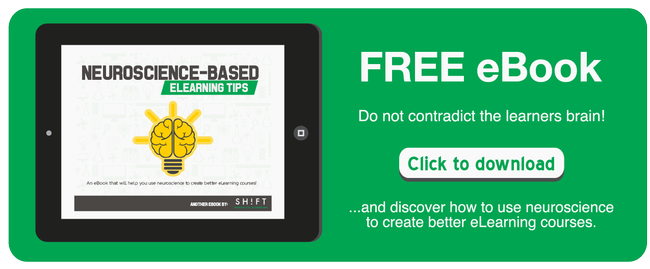 Have you ever stared at the computer wondering how to make your eLearning course more effective? Should you use different graphics or alter the way the information is presented? Perhaps you could realign the interface and make it more accessible to users or enhance the art of storytelling to increase user engagement?
Have you ever stared at the computer wondering how to make your eLearning course more effective? Should you use different graphics or alter the way the information is presented? Perhaps you could realign the interface and make it more accessible to users or enhance the art of storytelling to increase user engagement?
Each of these strategies may be beneficial to developing your eLearning course. Regardless of experience, all eLearning course designers and developers should continually seek new understanding and pursue ongoing developments in the field, and one of the best ways to do it is through reading books. Therefore, we have carefully selected six texts that form a basic eLearning library and examine these strategies in the context of improving your course designs. If you pair these reads with a few core texts, along with your own tutorials and practical understandings, you can have an incredible impact on your skills and ability to effectively craft eLearning courses.
Begin Learning Visual Communication Design
Recommended book #1: Visual Language for Designers: Principles for Creating Graphics by Connie Malamad.
This text provides readers the essential principles of visual communication design and its connection to cognitive science research. It demonstrates graphic and instructional design professionals how to create eLearning courses that adapt to how people read and interpret visual information.
After all eLearning is highly visual, so by fully understanding visual language they can inform and engage learners more completely. This book details how graphics, photography, typography, and animation may provide quick and effective communication when used properly. Among other things, you'll learn:
- How to organize graphics for quick perception
- How to direct the eyes to quickly see essential information
- How to use visual shorthand for efficient communication
- How to make abstract ideas concrete
- How to express visual complexity
- How to charge a graphic with energy and emotion
Dig Deeper Into User Experience
Recommended book #2: Don't Make Me Think by Steve Krug (Originally published in 2000, the book has a second edition (2005) and a revisited edition (2014).
The crux of the matter is that usability is high on every learner’s list. The course should be easy to use and simple to navigate. The course by itself has to encourage learners to focus on the content, not on navigation.
If usability is all too important, eLearning course developers should find ways to address user frustration issues and ways to increase user friendliness. Steve Krug’s book, focuses on human centered design and provides insight into how users interact with a web interface. It offers some fine insights into creating a usable learning environment that fosters learning. The concepts included are timeless, and they will provide a new perspective to effective eLearning design. It's short, abundantly illustrated, and very fun to read.
- Here are some things to think about in the meantime.
- Here is a free sample chapter if you would like to read first.
Recommended book #3:The Design of Everyday Things by Don Norman
The author details how user interfaces are designed and analyzes why some designs are more effective than others. It provides the reader with clear examples of good and bad design. Additionally, the book also examines why some users preform better depending on the aesthetics of the website. You’ll learn the essential lessons about how people really interact with the objects around them.
Don't feel like reading? Take this free course. It provides a summary of key concepts from the first two chapters of The Design of Everyday Things (Revised and Expanded Edition, November 2013) by Don Norman.
Empower Your Writing Skills
Recommended book #4: Made to Stick by Chip Heath and Dan Heath
The Heath brothers wrote this bestselling book, and in it they revealed why ideas stick or fade into oblivion. Why do people believe in a particular idea and hold on to them for years? The authors have already solved the riddle for us. For an idea to stick, it has to make people.
- Pay attention (to something unexpected)
- Understand and remember it (because it’s concrete)
- Believe in it (because it’s a credible idea)
- Truly care about it (or make an emotional connection with it)
- Be able to act on it (by telling it as a story)
In short, this text emphasizes the power of stories and how storytelling impacts effective eLearning design. It analysis details the ways storytelling can transform even the driest of data to become more appealing to the learner. Finding unique ways to deliver your eLearning content will help ensure that your user remembers it long after the course is over.
Understand How People Learn
Recommended book #5: Design for How People Learn by Julie Dirksen
Effective eLearning professionals design for how people learn. They don’t assume but rely instead on the contribution of experts and trained professionals even in other fields—psychology, neurology, usability, information technology and communications.
So, if you want to know how students Learn, this book is a good start. It details the key principles behind learning, attention, and memory and then applies them to effective eLearning design. You will learn how to leverage the concepts of instructional design to engage your audience and improve the overall eLearning experience. It also includes a variety of concrete ways to enhance eLearning courses to better match how learners actually master new concepts.
Learn Design for Multimedia eLearning
Recommended book #6: eLearning and the Science of Instruction: Proven Guidelines for Consumers of Multimedia Learning by Ruth C. Clark and Richard E. Mayer.
Effective eLearning instruction is far different from effective instruction in a face to face setting. There are suggested criteria for the design, selection, and development of eLearning courses and ways to make them highly effective for users. The authors detail these criteria throughout the book and make recommendations for building knowledge, leveraging the benefits of eLearning courses, and practical ways to transfer traditional modes of instructional delivery to an online environment.









